Are you looking for more blog post ideas on what to write next? Here are 30+ awesome blog post ideas to fill up your content calendar and drive traffic to your website.
Are you looking for more blog post ideas on what to write next? Here are 30+ awesome blog post ideas to fill up your content calendar and drive traffic to your website.
Do you know 1 in 4 bloggers reported that their blog delivers strong marketing results?
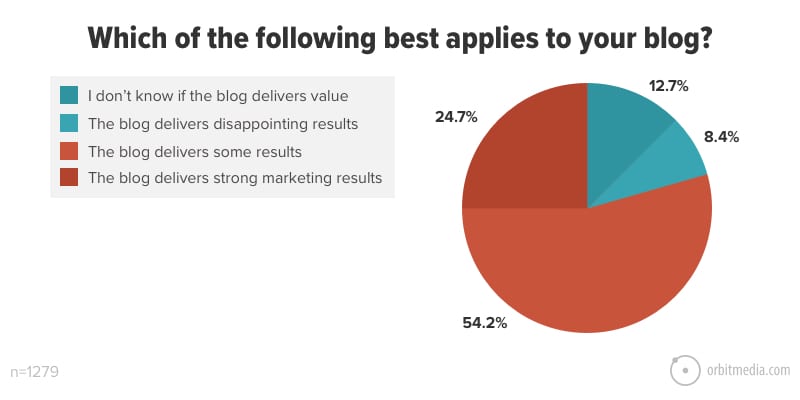
Since more bloggers see results in their blogging efforts, it is no surprise that the number of bloggers is expected to grow to 31.7 million in 2020.
In other words, we would probably see more blogs publish every day.
If you’re running a blog, it’s essential to have a consistent number of posts published. It’s not just for the sake of giving a signal to the search engine that your website is alive, but also to your existing readers.
Other than that, you can also use the blog to reach out to a new customer. Write great content that ranks well, and you will see brand visibility comes along. That way, you will see more traffic to your website and more chances of turning it into conversion and sales.
That sounds great, isn’t it?
Now, what do we blog about? Or how to find blog post ideas?
I’ve faced the same question several times, and I hate it.
That’s why I have prepared a list of great blog post ideas for you. Bookmark this page if you want so that you can always have a “cheat sheet” whenever that question pops up again.
Blog Topic Ideas That Your Readers Will Love
1. Brand story
80% of people want your brand to tell stories. Give your audiences a little insight into how your brand came to be. Customers love brand stories. Don’t cook it, but tell it compellingly. Aim to inspire someone and show them how you are more than just a business.
The North Face did a great job of telling their brand story. The brand’s story communicates its mantra, “Never stop exploring”, perfectly to their target customers.

2. Explainer videos of your offerings
If this were 2070, and Space XAEXX was your company of fleet capsules to and from Mars, it would help to post explainer videos of how the company operates, the journey through the galaxies, the technicalities, and everything in between.
In other words, using explainer videos in your blog is an excellent way to explain complicated stuff.
3. Resource post of pure links
Let’s assume you’d need to review a post on the best way to grow a startup and catapult it to the Fortune 500 list. It may take a lot of time to research the approaches and speaking to experts. But how about you compile a dozen links or so to these expert’s websites? That can serve your audiences equally well.
Here’s a blog post example by Paleo Grubs:
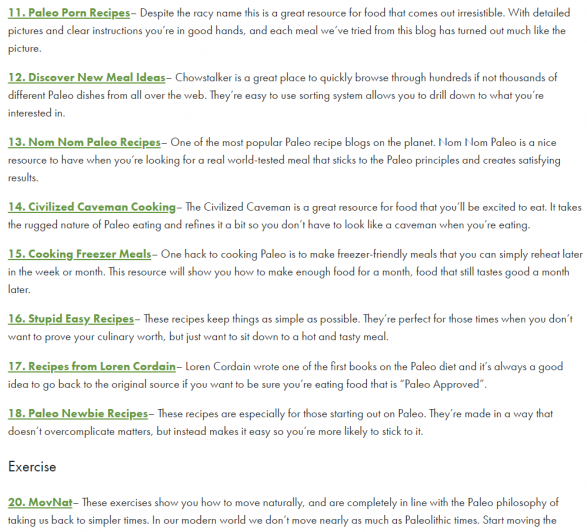
4. A compilation of FAQs
People may have many questions about your product, service, or niche. You can compile a list of questions that you frequently get asked and write comprehensive responses to them. Make up the things that individuals would presumably get some information about your item or administration. What things could be an issue that individuals may require greater clearness?
Here’s a blog post example by Atkins:

5. News or news commentary
56% of people are interested to know your COVID 19 strategy.
Take something from the news relevant to your niche or business and transform it into an excellent blog post.
News analysis helps your audiences understand what GDPR means for their business, for instance, if they handle customer data on their website.
You can talk about anything from the price of oil to an election in India if it somehow relates to your business.
6. Guest posts
Readers get bored sometimes. You can change your blog post’s voice, theme, and tone by publishing a guest post. This is a chance to break the monotony and feed them something new that could be of unique value.
Visitor posting is such an extraordinary method to get more adherents and construct authority. Ensure that when you pitch influencers, you put in your absolute best effort.
7. Publish an ‘us vs. them’ post to distinguish your brand from competitors
It may be a wise idea to draw comparisons between you and your competitors. You must show your audiences why you are the best, but don’t say it directly—provide compelling reasons and let the customer be the judge. Otherwise, the reader may see your brand as boastful, arrogant, good for nothing, and out of touch with customer needs.
When talking about your competitors, don’t mention them by name. Instead, say something like “the other leading brand/product.” Your competitors could slap you with a defamation suit if you directly mention them the wrong way.
Here is a blog post example from us:

8. Share the creative and least-known ways people can use your products
At BiQ, we have had people tell us that they have used our keyword research techniques to get more streams on Spotify or YouTube. SEO for streaming sites is one unique and underexplored application of keyword research tools.
If your product has been used in such an unexpected way, isn’t that news worth sharing?
9. Do a roundup post by experts in your niche
One medical marijuana website spoke to 50 leading doctors in the state about the Sativa herb’s medicinal benefits. They compiled that into a full blog post, each expert getting a paragraph to say something unique. Engagement rates doubled.
Check out this awesome roundup post from SmartBlogger:
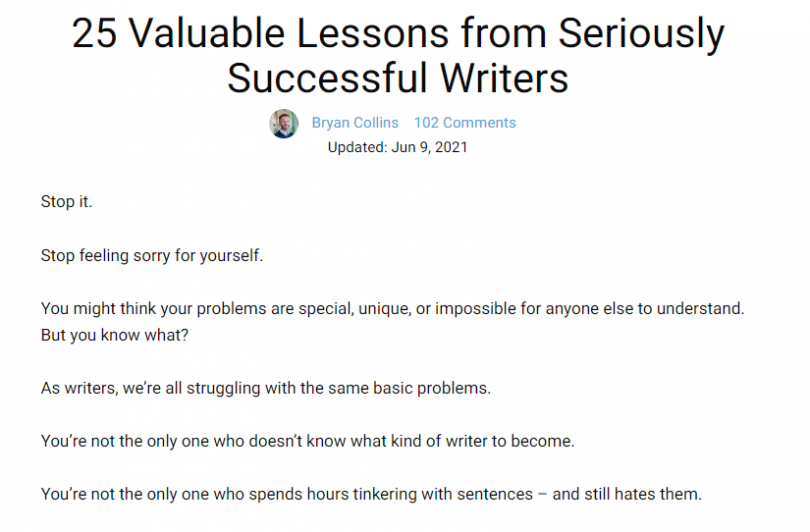
10. Make a comprehensive guide
Create a long post, a complete manual for something in your industry. Show individuals the little-known techniques, and they’ll be overly grateful.
For example, we have created a blog post on four ways to perform a fast SEO analysis of your website using BiQ. Here is a snippet of the blog post:

11. What is the best part of what you do?
Give readers a sneak peek into what goes on in your business. Are there any great experiences that you’ve had the chance to be a part of while doing what you do?
12. Post a Q&A meet with your teams
A great blog post example is recording, transcribing, and posting an interview session you had with your teams, clients, or other stakeholders. You can also transcribe your webinar or a recent YouTube video.
Here is a cool example of Q&A blog post from Zappos:
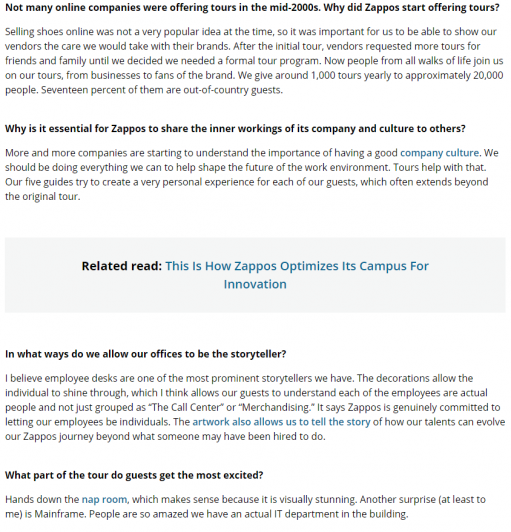
13. Announce an offer
A pronouncement is an excellent method to gather your message into a short, comprehensive arrangement. If you’ve composed it well, they will get a full comprehension of your center message, which you may have been attempting to convey for quite a long time.
14. Encourage user-generated content
Encourage your audiences to write reviews about their experience with your offerings. Or encourage them to vote on something such as the best TV shows, the best season in the Premier League, or the best restaurants near them. Aim for relevance. You can then compile the views into a single blog post.
15. Mine content ideas from Quora
Quora has 300 million monthly users, and it’s still growing. You may find a handful of great content ideas from the platform because there are countless questions about diverse life topics.
You can pick a question relevant to what you do and provide a comprehensive answer—in the form of a blog post.
Quora will post a snippet of the answer on the community site and provide a link to your site for readers to get the full details. Responding to questions on Quora is a surefire approach to increase inbound traffic.
16. Celebrate your brand’s birthday.
Your brand has a life, and your customers share in it. Never miss a chance to share and celebrate your brand’s anniversary via a blog post. Accompany the announcement with an offer such as a discount, and encourage people to act fast before it expires!
Here’s a great birthday post example by Atlassian:

17. Write about how your people work
If you operate a restaurant, let your audience get into the kitchen. Let them experience the heat for once. The day, for a head chef, begins at 6 am and ends at midnight. The kitchen is a hot, stressful, and yet exciting place to work. Paint a vivid picture of something like that.
18. Review your accomplishment
Getting a hundred followers on Facebook or a thousand views on YouTube is something you can write about. You can take that chance to thank the people, promise an offer for new subscriptions, or reinforce your commitment to quality and affordable products and services.
Or you can also talk about what your brand has achieved for the year. Here is an example of Zappos’ 20 milestones in 20 years:

19. Letter from the CEO
Have the president write a personal and heartfelt letter to the customers. Please send it via email to your beloved customers, but also publish it on your site. He/she could talk about business resilience in the face of the pandemic or in light of changes in regulations. He/she could surprise customers by announcing cost reductions and explaining the reasons why.
20. Repurpose content from your recent speech
Did you recently attend a conference or fundraiser? Did you participate in market research? Turn your speech into a blog post to get more value from it.
21. Talk about your business resilience
Every now and then, customers are apprehensive.
Will they get their orders delivered the same way as before in the face of lockdowns? Will their products be rendered obsolete in the next rollout of updates? These are just examples.
Explain to customers how you are staying agile to technological and other changes and how you are prepared to shield them from disruptions.
Here’s an example of how StoreHub encourages their customers to sell online via StoreHub Ecommerce:
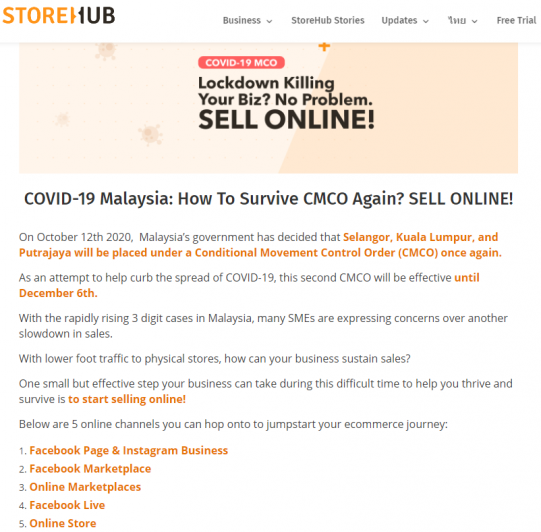
22. Host an influencer on your blog.
Need to get more customers? Hosting influencers on your blog can genuinely inspire new interest among your customers. It helps if the person you pick is relevant with an indisputable influencer status.
23. What are the killer mistakes when using your product?
Customers want excellent performance and longevity with your products. Take this opportunity to write about dos and don’ts when using your product. Compile a full and easy-to-follow care routine to reduce maintenance costs and improve durability.
24. Bust a couple of myths
It is the age of fake news, and most of that may turn out to be unfavorable for your niche, brand, or offer. List down the myths and offer the real truth for every untruth purveyed by those who don’t check their facts.
For example, Minimalist Vegan talked about the ten common myths that relate to minimalism:

25. Read old books and magazines
It’s a fact that no one no longer cares to peruse magazines and books published more than 20 years ago. This is your pot of gold for content ideas.
Reading incredible books and magazines accomplishes more than assisting you with marketing ideas. It can help you appeal to audiences in ways that were only possible in the good old days.
If you read something new consistently, you’ll never run out of thoughts to expound on.
26. Be an avid not taker
Take notes on pretty much all that you see around the web. Write it down and feed what you compile into your content strategy. When you see something around the web that applies to a post you have been considering, take note.
27. Engage some more
As a business, you exist because of clients. All your blog post examples will have to resonate with their needs and interests at the end of the day. There is no better way to make your content customer-centric than by engaging them online.
Speak to them on your website and social media and note all the issues and difficulties they’re confronting. These difficulties may not necessarily be identified with your offering, but still, strategize to provide solutions through new blog posts.
By conversing with your clients and taking care of issues for them — regardless of whether those issues aren’t identified with your brand— solidify relationships and make these people want to work with you in the future.
28. Copy from the best
Until the day when you will become a content guru, copy from the best. Don’t claim ownership of somebody else’s work; that is copyright infringement. Use it for inspiration and give credit when you have to.
You can steal ideas through hundreds of blogs, and afterward, put your own personal turn on what you have learned. In any case, their people are not your people. Whenever you ‘steal’ content, you must personalize it for your people, and in that process, you make it unique.
29. Conduct in-depth keyword research
You could spend many days trying to find out on Google what people are searching for.
Or you could simply enter any keywords or phrases in BiQ’s Keyword Intelligence.
You will get to see the related searches that people are interested in. Not to forget, all these keywords come with vital insights such as how many people are searching for the keywords, what is the searcher’s intent, and so on. Here is how it looks like:

If you are interested in getting some ideas on trending searches, switch to the “Trending Searches” tab. You will see a list of trending topics that give you inspiration on what to write next.
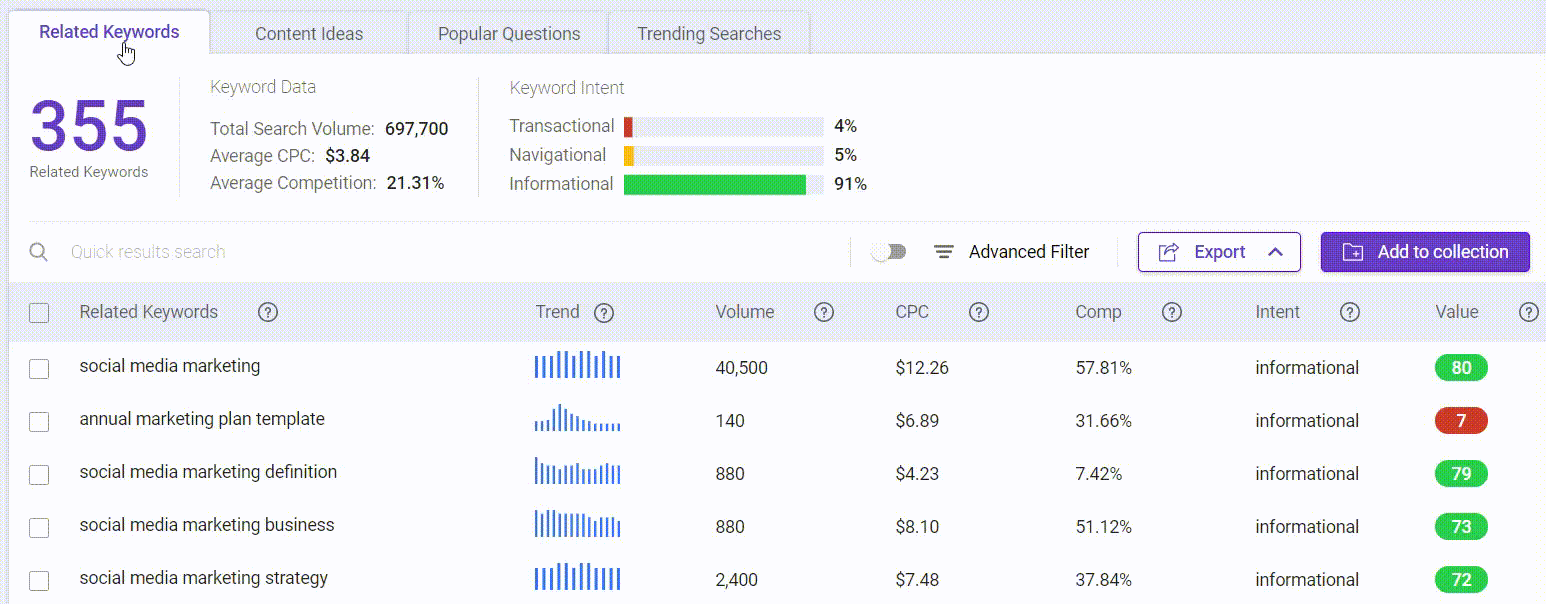
30. Reformat your current content
Don’t waste great content. A TV ad can run for months and months or even years, but why not your blog post?
If it was great content with high engagement and conversions, you could publish it in different formats again and again.
Some people believe that you close the books once you have published content on a topic and count it as forgotten. That’s a wasteful philosophy given that different people consume content differently.
You could turn the blog into an infographic for your people who love data. You can change the heading and update a few things in it for your audiences that love news. You can turn it into an e-book, a case study, a short, or a checklist of bullet points—your options are endless.
31. Publish micro-content
Long posts can be incredibly valuable to your readers as they give them all the details on what they should know, easing research. Long posts are also good for ranking. Google loves them. But that shouldn’t be a reason never to publish a short-format blog split.
Sometimes readers want short, precise, and scannable content. It will do you a lot of good at the point of purchase. It is a chance to create something new swiftly and to break up the monotony on your site.
Instead of going through all of your old blog posts, you can start by checking your top-performing blog post using Rank Intelligence.
It will tell you instantly show your top-performing blog posts that ranking high on the search engine.
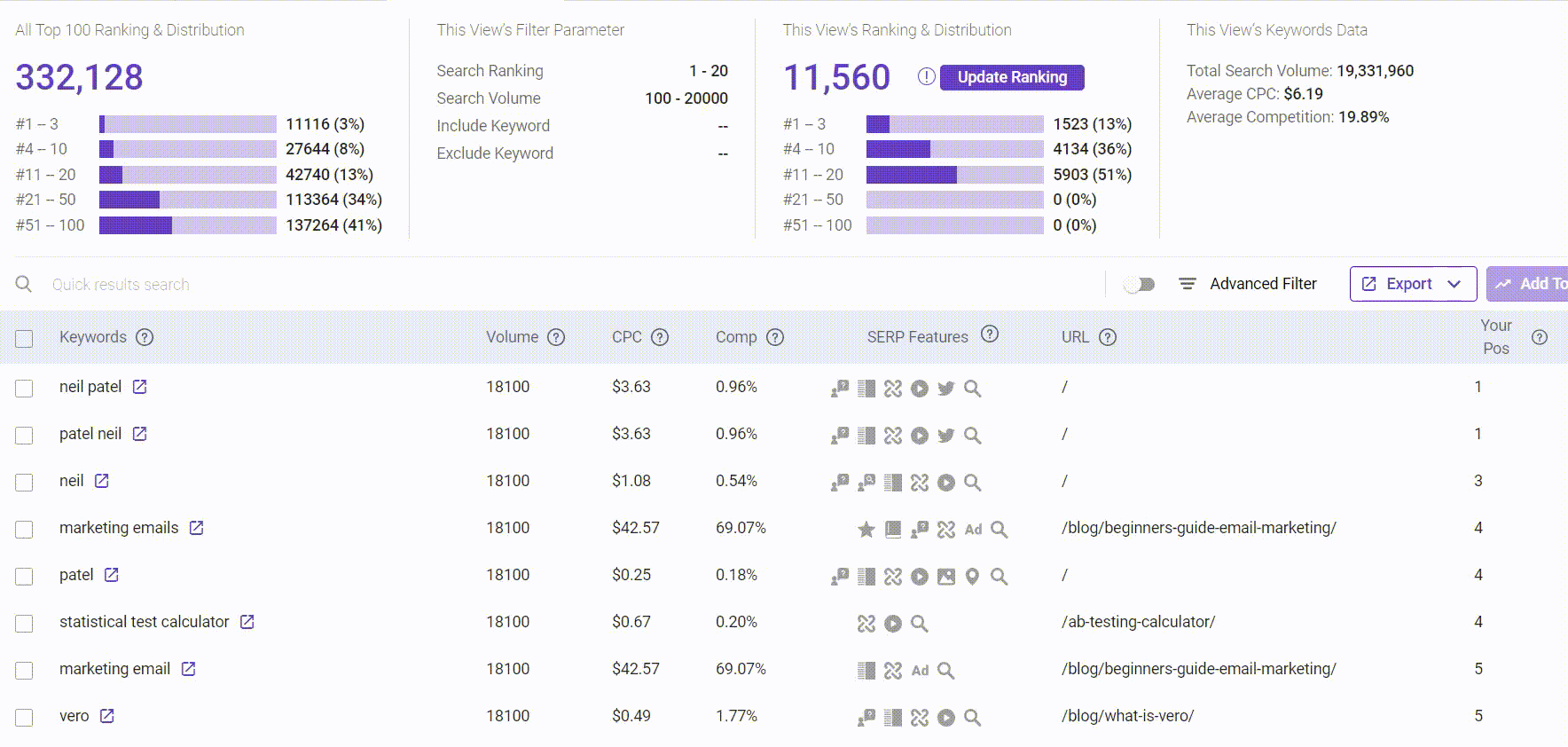
Filter the results to see those keywords that have high search volume and rank on the first page.

Then, choose the blog post that you can split into a short-format blog.
Now Back To You
That’s it. Thirty-one creative blog post ideas and tips to help you start creating the best content for your website or blog.
I hope it will trigger even more ideas as you read and think through what I have listed here.
What are your best blog post ideas? Let me know in the comments section!




